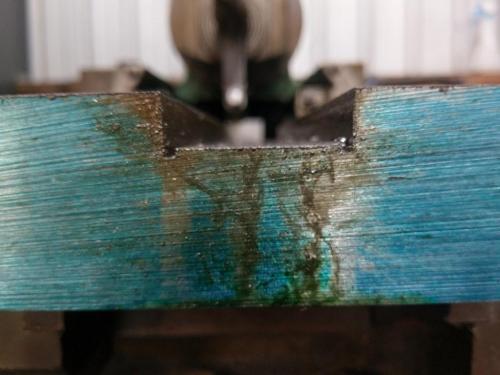I've managed to get a few hours on the shaper to dig a trench in the chunk of forklift tyne that will become some QCTP holders.
I made a couple of grooves with a parting tool to give me vertical sides to work to, plunged cuts with the parting tool cut nicely, I took a couple of photos of that but seem to have misplaced them.
I used a round-nosed tool working from side to side between the narrow slots. This necessitated a plunge cut at each side of the trench, the tool chattered heaps on the plunge cut, plunging .010" in 3 strokes but cut smoothly as I fed across. I moved the feed screw manually across the cut from side to side, plunge with the topslide then feed back the other way.
First photo shows the rough finish from the round-nose tool with a .010"-.012" depth of cut and moving across about .060"-.080" per pass. I took a .005" depth of cut and nudged the feedscrew about .010" or so per stroke for the final few passes as I approached depth, got a decent enough finish. You can also just see the round-nose tool, it's mounted in a lathe Armstrong holder (I don't have any shaper ones), I left the top flat, put a radius on it and gave it some relief all around.



This took hours. Would have been a lot quicker to do this in the horizontal mill but I wanted to do the dovetail work without disturbing the setup. I'm sure there are quicker ways of achieving this in the shaper too but I'm yet to learn them. Not a bad way to while away a few hours anyway.
Next job is to grind a double-ended dovetail tool and cut the sides out of the trench.
Lathe (n); a machine tool used in the production of milling machine components.
Milling Machine (n); a machine tool used in the production of lathe components.
 I want to come to the dumpsters that throw out DI's.
I want to come to the dumpsters that throw out DI's.
 I want to come to the dumpsters that throw out DI's.
I want to come to the dumpsters that throw out DI's.





